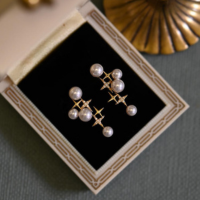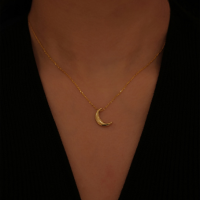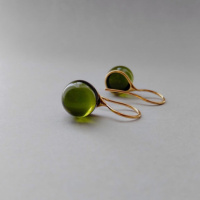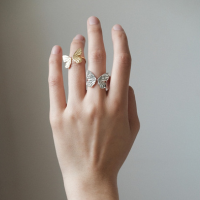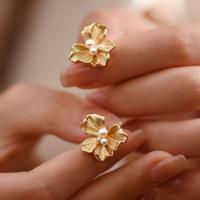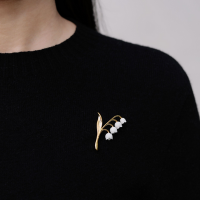
How to Clean Jewelry with Vinegar
Check out our personalized jewelry collections! (kids drawing jewelry, coin jewelry, wire jewelry, fingerprint jewelry, handwriting jewelry, and more)
Jewelry can lose its shine over time, looking dull or tarnished. That's where a simple household item like vinegar comes in handy. Vinegar is a natural, affordable solution to clean and restore the sparkle of your jewelry.
It's amazing how a common product in our kitchens can work wonders on various types of jewelry. By mixing vinegar with other ingredients, we can make an effective cleaning solution that works safely on metals and stones. Let's explore how we can use vinegar to care for our treasured pieces.
Many of us have different types of jewelry that we want to keep in good condition. Each type may have special needs during cleaning. We'll share the correct steps and precautions, ensuring our jewelry remains beautiful for years to come.
Key Takeaways
- Vinegar is a cost-effective cleaning solution.
- Use specific methods for different jewelry types.
- Follow safety tips when cleaning with vinegar.
Benefits of Using Vinegar for Jewelry Cleaning
Vinegar is a natural cleaning agent that helps keep our jewelry sparkling. It’s safe for the environment and doesn't cost much, making it a smart choice for those who love their accessories.
Natural and Non-Toxic
We care about safety, both for our skin and the planet. Vinegar is a natural option, free from the harmful chemicals often found in commercial cleaners. This means we can clean our jewelry without worrying about harsh ingredients.
Being non-toxic, vinegar is safe to use around the house and for us to handle. Since it’s natural, there are fewer risks of allergic reactions or skin irritations. It’s also a biodegradable choice, making it safe for the environment when washed away.
Cost-Effective Solution
We all like to save money where we can. Using vinegar for jewelry cleaning is easy on the wallet. Vinegar is inexpensive and found in most homes. We don't need costly store-bought cleaners, which can add up over time.
A little vinegar goes a long way. We only need small amounts for each cleaning session. This means less spending without sacrificing our jewelry's shine. It's a thrifty way to maintain that elegant sparkle we all love.
Gentle on Most Metals and Gemstones
Caring for our jewelry means choosing the right cleaning method. Vinegar is gentle on most metals, like gold and silver. It cleans without causing scratches or tarnishing the surface.
For many gemstones, vinegar is also a safe choice. Properly diluted, it can bring out their shine without damaging them. We should be careful with some softer stones, making sure the vinegar is well-diluted. Overall, vinegar balances being effective and gentle, keeping our precious pieces looking their best.
Preparing Your Vinegar Cleaning Solution
Creating a vinegar cleaning solution for your jewelry is simple. The right type of vinegar and adding other natural ingredients can enhance the cleaning power and protect your pieces.
Selecting the Right Type of Vinegar
We recommend using white vinegar. Its acidity level makes it effective for cleaning most types of jewelry as it can safely remove tarnish. Apple cider vinegar is another option; it is milder, which might be better for delicate stones.
Avoid balsamic or flavored vinegars as they might leave unwanted residues. Check each piece of jewelry’s care instructions to ensure vinegar won't harm it. Not all metals and stones react well to acidic cleaners.
Mixing Vinegar with Other Natural Cleaners
Combining vinegar with natural ingredients can boost its cleaning ability. A simple way is to mix one part vinegar with two parts water for a basic solution. Baking soda is a great addition; sprinkle a small amount into the vinegar and watch it fizz.
This reaction helps lift grime from crevices. Salt is another option, aiding in scrubbing power, especially for metals like silver. Stir until the ingredients dissolve completely. Test a small portion of your jewelry first to ensure there’s no adverse reaction.
Step-by-Step Guide to Cleaning Jewelry with Vinegar
Cleaning our cherished jewelry pieces can be easy and effective with vinegar. This guide shows how to clean, soak, scrub, rinse, and dry jewelry pieces, bringing back their sparkle safely.
Inspecting Your Jewelry
Before we start, let's examine the jewelry. Check for loose stones or weak settings. Vinegar is safe for most metals and stones, but it's best to be cautious. Avoid using vinegar on pearls, opals, and other porous gems as they can get damaged. Ensure there's nothing that could fall off during cleaning. Prepare a small, soft cloth or a magnifying glass if needed for closer inspection.
Soaking the Jewelry
Prepare a solution of equal parts vinegar and warm water in a bowl. Place the jewelry in the solution, ensuring it's fully submerged. Let it soak for 10-15 minutes to help loosen dirt and grime. If the jewelry is heavily soiled, consider letting it sit a bit longer, but keep checking to avoid any potential damage. This step is crucial for thorough cleaning.
Gentle Scrubbing Techniques
After soaking, we gently scrub the jewelry to remove any remaining dirt. Use a soft-bristled toothbrush or a gentle brush. Focus on crevices where dirt collects, applying light pressure. Avoid scrubbing too harshly to prevent scratches. For stubborn spots, dip the brush in the vinegar solution and try again. This helps maintain the natural glimmer of our pieces without causing damage.
Rinsing and Drying
Once scrubbed, rinse each piece under lukewarm water. Make sure to remove all vinegar traces to prevent residue. Rinse thoroughly but carefully to avoid losing any smaller pieces. After rinsing, gently pat the jewelry dry with a clean, soft cloth. Lay the pieces out on a towel to air dry completely before storing or wearing them. Ensure they are fully dry to prevent tarnishing or discoloration.
Specific Tips for Different Types of Jewelry
When cleaning jewelry with vinegar, it's important to consider the type of material. Silver, gold, and gemstone pieces each require different care to keep them looking their best. Let's dive into the specifics for each type.
Silver Items
For silver jewelry, we start by mixing half a cup of white vinegar with two tablespoons of baking soda. Immerse the silver items in this solution for two to three hours. After soaking, rinse each piece with cold water and dry it thoroughly, using a soft, clean cloth.
Quick Tip: To prevent tarnishing, store silver jewelry in airtight bags. Regular cleaning maintains their shine and helps extend their lifespan.
Gold Pieces
Gold jewelry benefits from a simple cleaning method using vinegar. Combine one cup of warm water with a few tablespoons of vinegar in a bowl. Submerge the gold items for about 15 minutes. Afterward, gently scrub with a soft toothbrush to remove any remaining dirt.
After cleaning, rinse the gold pieces under running water and pat them dry with a lint-free cloth. This keeps them shiny and free from damage.
Gemstone-Set Jewelry
Cleaning gemstone-set jewelry requires more care to avoid damaging the stones. Mix a solution of vinegar and warm water in equal parts. Instead of soaking, dip a soft cloth into the mixture and wipe across the pieces.
Be cautious: Make sure to avoid soaking pearls or porous stones. Rinse the jewelry with a damp cloth to remove any residual mixture, then gently pat dry. This ensures the gemstones stay vibrant without risking any damage.
Maintaining Jewelry After Cleaning
Keeping our jewelry in great condition doesn't stop after cleaning. Proper storage and a regular cleaning routine help preserve its shine and prevent damage.
Storing Jewelry Properly
We should store our jewelry in a clean, dry place. This protects it from moisture and tarnishing. Using a soft-lined jewelry box or a pouch can prevent scratches. Keeping pieces separate is important to avoid tangles and scratches.
Let's not forget about rings and bracelets, which can get scratched or bent if not stored properly. A divided jewelry box or individual soft bags work well.
Avoiding direct sunlight is crucial because it can fade some gemstones. Humidity can also be harmful, so we might use a silica gel packet to absorb excess moisture.
Regular Cleaning Schedule
Setting up a regular cleaning schedule is key to maintaining our jewelry's sparkle. We should gently clean jewelry every few months using mild cleaning solutions.
It’s important to avoid harsh chemicals as they may harm metals and stones. For most pieces, a simple mix of soap and water will do. A soft toothbrush can help get into small crevices.
We should also keep an eye on gems to ensure they stay secure in their settings. If setting looks loose, it's best to have it checked by a professional.
Let’s make sure to dry jewelry thoroughly with a soft cloth to prevent water spots. Regular maintenance keeps our favorite pieces looking beautiful.
Troubleshooting Common Issues
Cleaning jewelry with vinegar can be simple, but a few issues might arise. Let's tackle them together.
Discoloration: If your jewelry is discolored, it may not react well with vinegar. This can happen with delicate or plated pieces. Always test on a small spot first.
Residue: Sometimes a white residue appears after cleaning. Rinse thoroughly with water and dry with a soft cloth to remove it.
Strong Smell: Vinegar’s scent can linger. Rinse your jewelry in soapy water to neutralize the smell. Ensure it's completely dry afterward.
| Problem | Solution |
|---|---|
| Tarnish not removed | Soak longer, then scrub gently with a soft toothbrush |
| Dull appearance | Polish with a soft cloth after rinsing |
Sensitive Skin: Some of us have sensitive skin that can react to vinegar. Use gloves to protect your hands while cleaning.
Loose Stones: Check for any loose settings or stones before cleaning. This helps avoid any unexpected losses.
We hope these tips help keep our jewelry looking its best. Always handle our favorite pieces with care!
Safety Precautions When Handling Vinegar
Vinegar is great for cleaning jewelry, but we need to handle it with care. It's an acid, which means it can irritate our skin and eyes. Let's be cautious.
Wear Gloves:
To protect our hands, we should wear gloves. This keeps vinegar away from our skin and prevents irritation.
Avoid Eyes and Face:
We must be careful to keep vinegar away from our eyes and face. It can cause a burning sensation if it accidentally splashes.
Proper Ventilation:
Using vinegar in a well-ventilated area is a must. This helps prevent breathing in any strong fumes that might be harmful.
Use Proper Containers:
Let's make sure to use containers that can handle vinegar. Glass or plastic bowls work well and keep the area clean.
Safe Storage:
After using vinegar, we should store it properly. Keeping it in its original container with the lid tightly closed will prevent spills.
By following these tips, we can safely clean our jewelry and protect ourselves. Proper handling makes the cleaning process easy and worry-free.
Frequently Asked Questions
We find that vinegar is an effective option for cleaning jewelry and restoring its shine. By using this simple ingredient alongside others like baking soda or lemon, we can safely clean many types of jewelry at home.
What are the steps to make my jewelry sparkle using a vinegar and baking soda solution?
First, combine ½ cup white vinegar and two tablespoons of baking soda in a bowl. Soak the jewelry for about two to three hours. Rinse and dry it gently with a soft cloth to reveal the shine. This method works well for silver and many other non-delicate pieces.
Can I safely use a mixture of vinegar and lemon to brighten my jewelry at home?
Yes, we can mix equal parts vinegar and lemon juice for a natural cleaner. Soak the jewelry for about 30 minutes, then rinse and dry with a soft cloth. It's an easy way to brighten many types of metal jewelry.
What's the best recipe for a homemade jewelry cleaner involving common household ingredients?
Our favorite recipe uses ½ cup vinegar, two tablespoons baking soda, and a touch of dish soap. Soak jewelry for about two hours, then rinse and dry. It's a simple and effective way to clean your pieces safely.
Are there any materials or stones that should not be cleaned using vinegar solutions?
Avoid using vinegar on pearls, opals, and other delicate stones as vinegar's acidity may damage them. For these stones, we recommend using just mild soap and water. Always check if your stones can tolerate vinegar before cleaning.
How can I quickly restore shine to my jewelry using products found in my kitchen?
We recommend using a quick mix of baking soda and a few drops of water to make a paste. Gently rub onto the jewelry with a cloth or soft toothbrush, then rinse. This fast method helps us restore shine without soaking.
What is the proper method for cleaning delicate gold pieces with a vinegar-based solution?
When cleaning gold with vinegar, mix ½ cup vinegar with a small amount of mild dish soap. Soak the gold pieces for 15 minutes, then gently scrub with a soft toothbrush if needed. Rinse thoroughly and dry with a soft cloth. Consider this approach when dealing with simpler gold jewelry.

